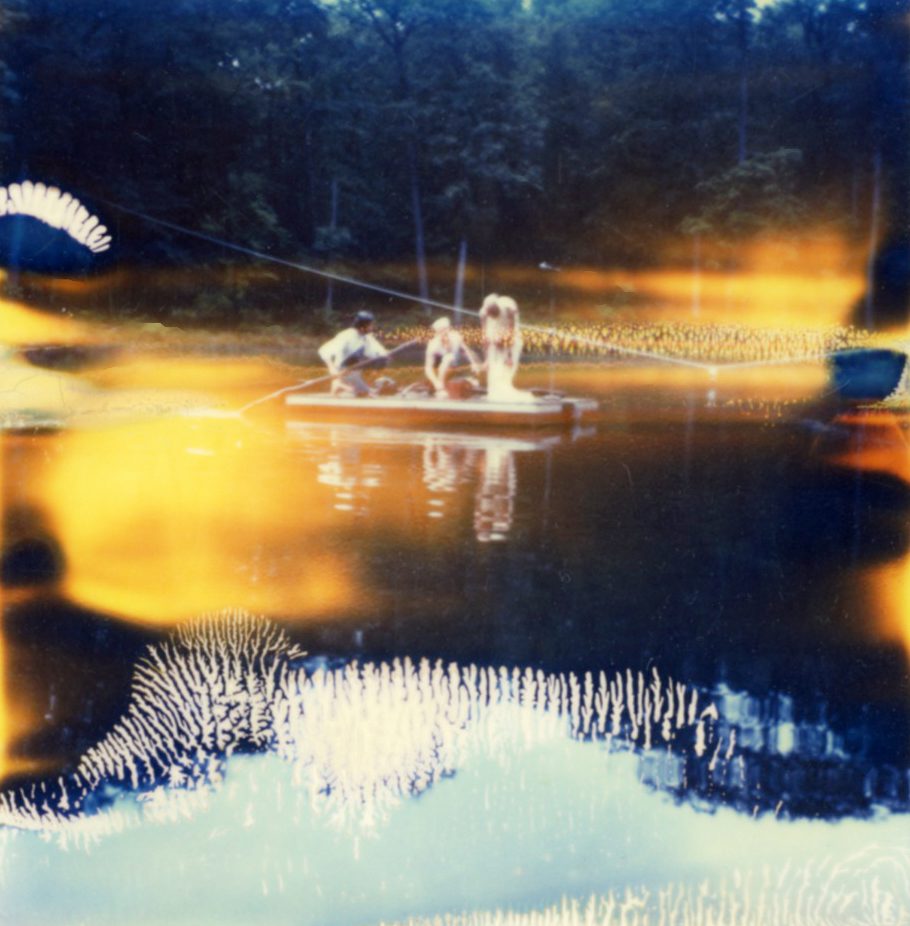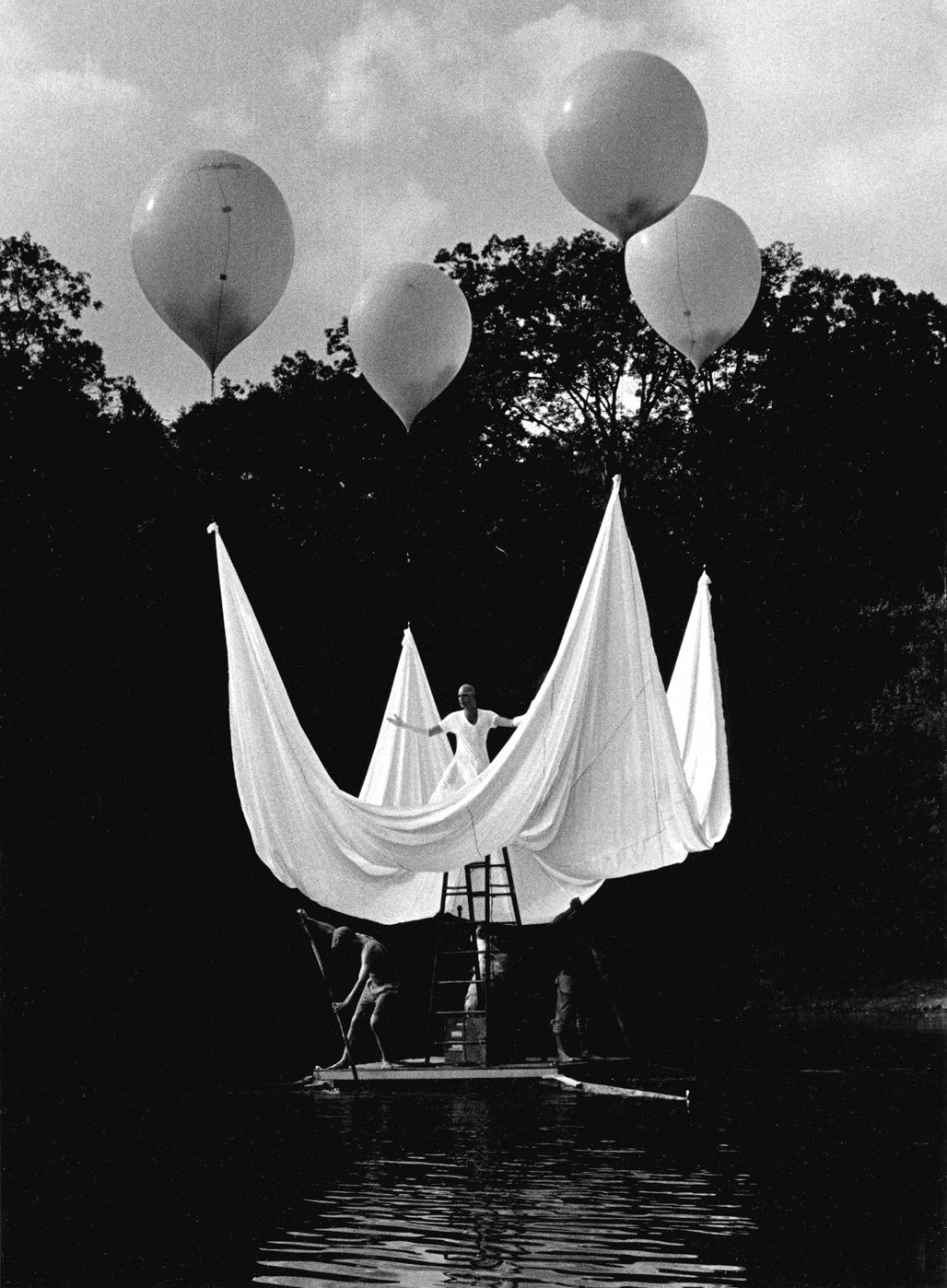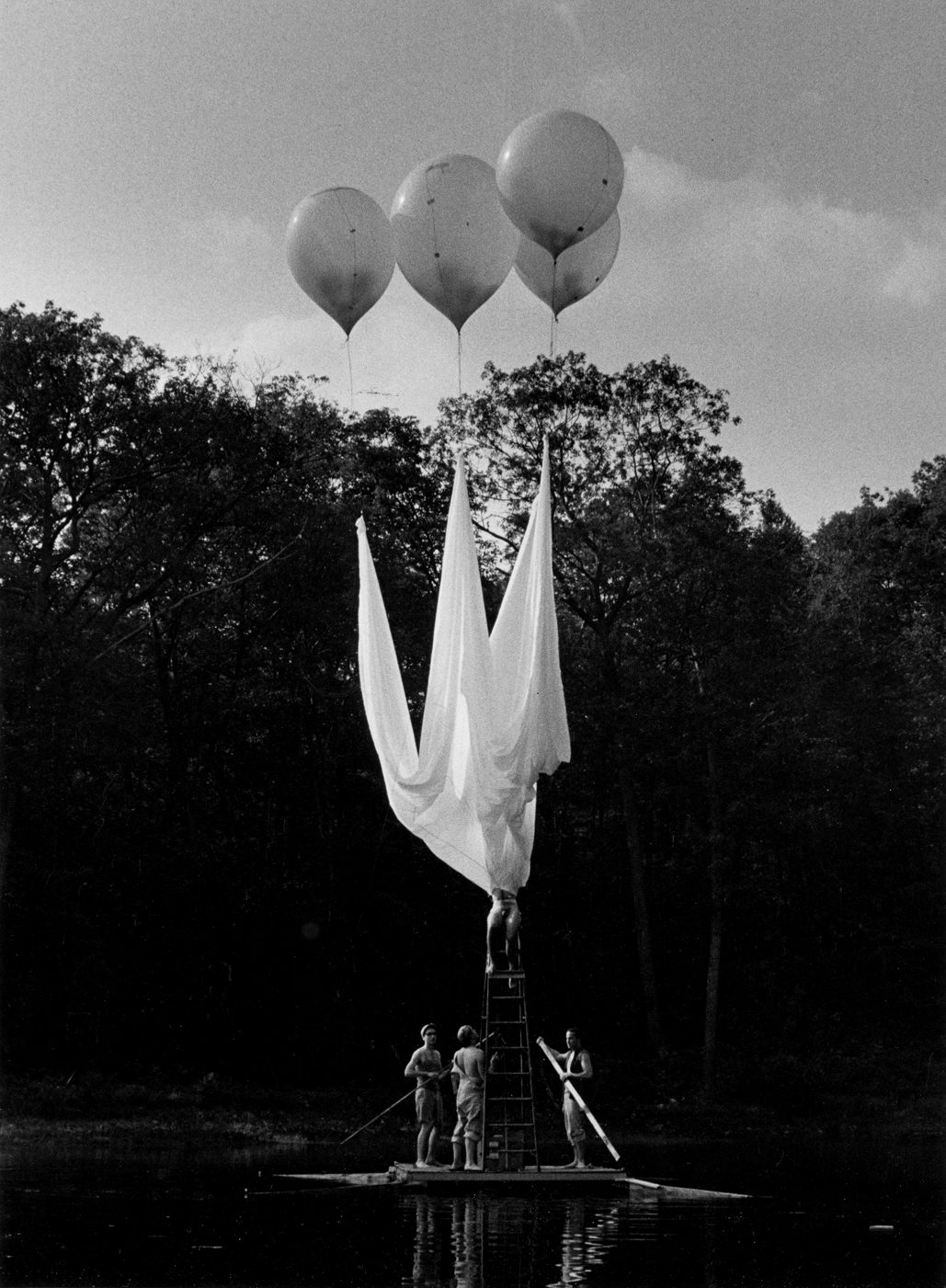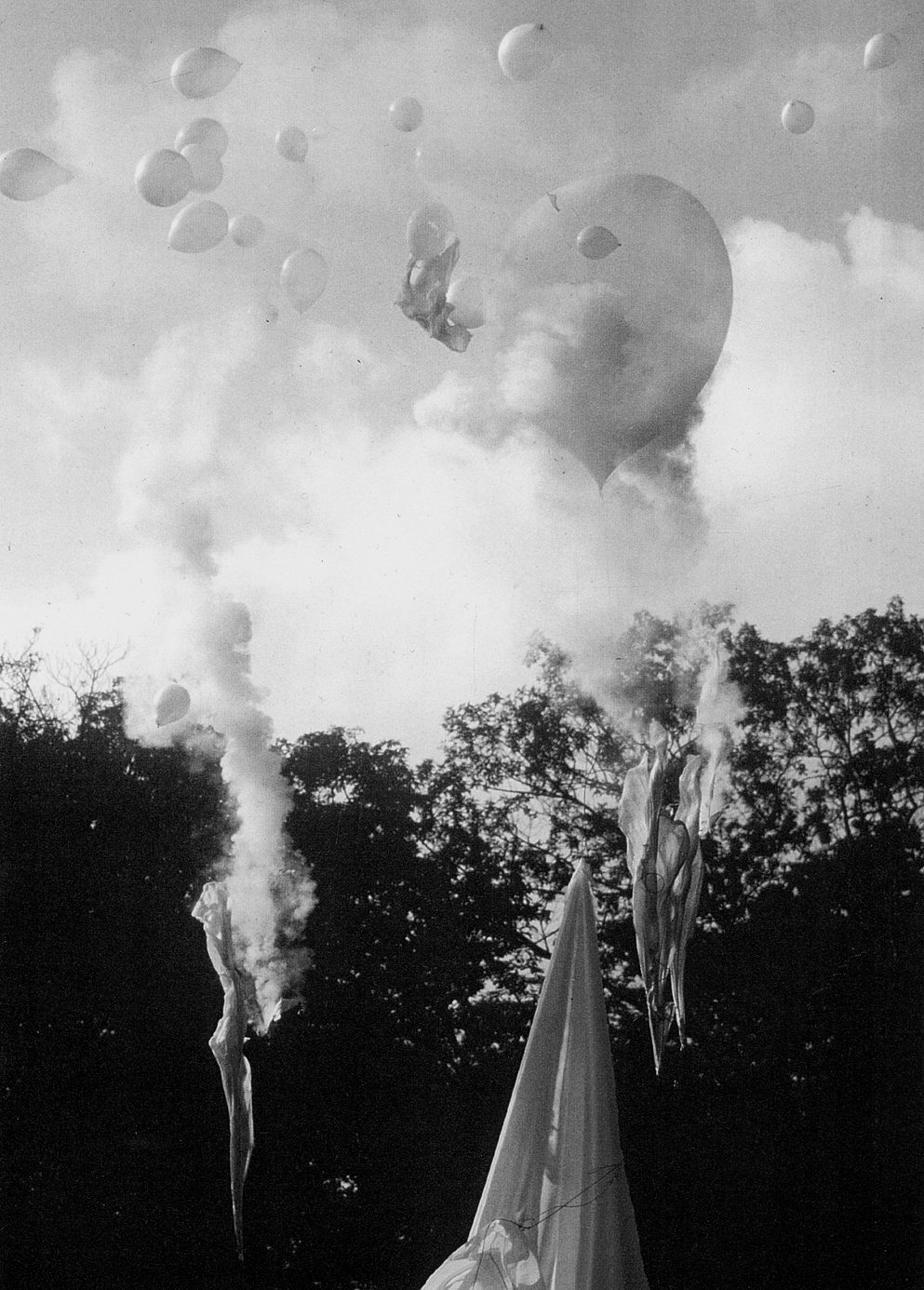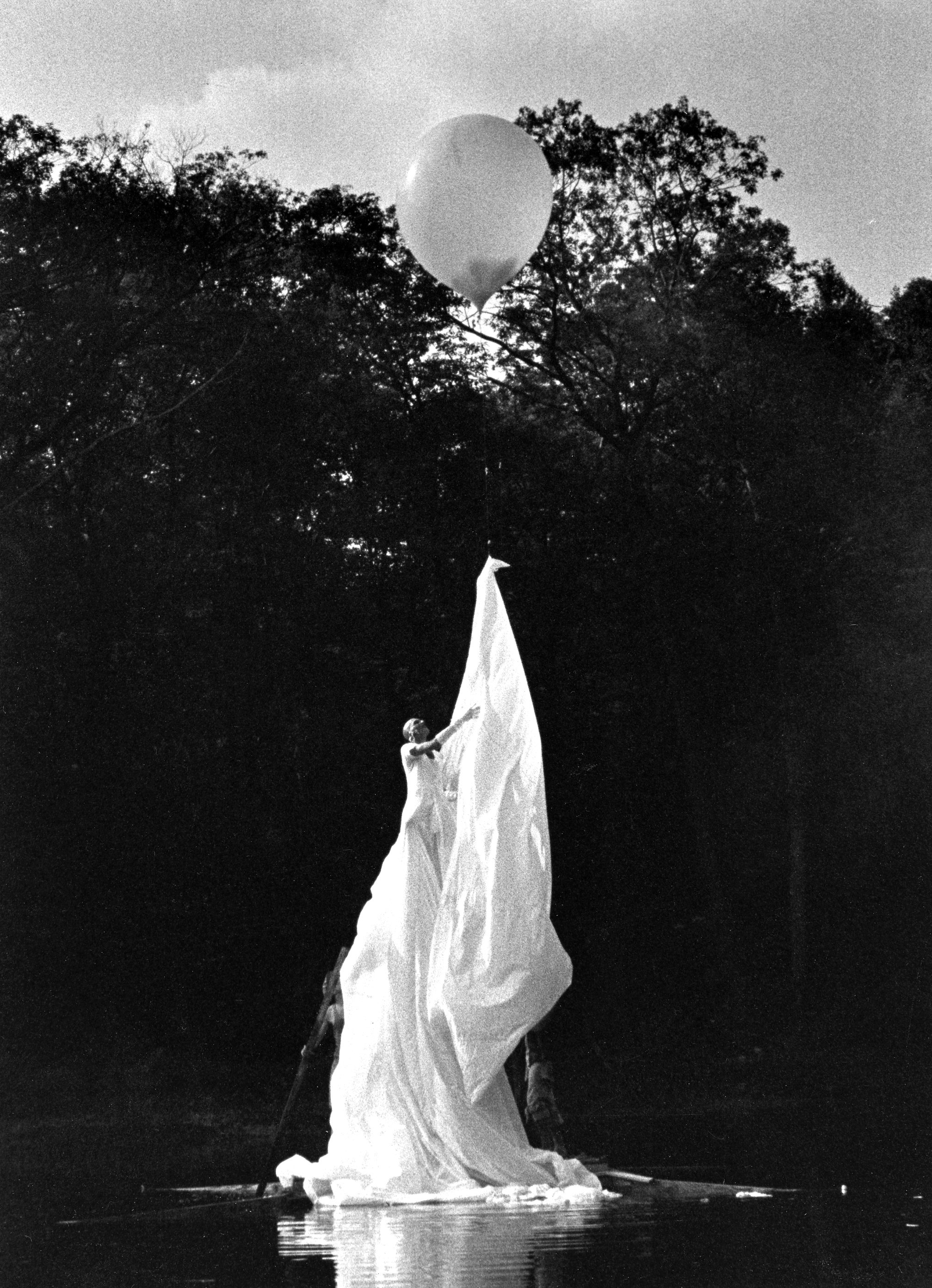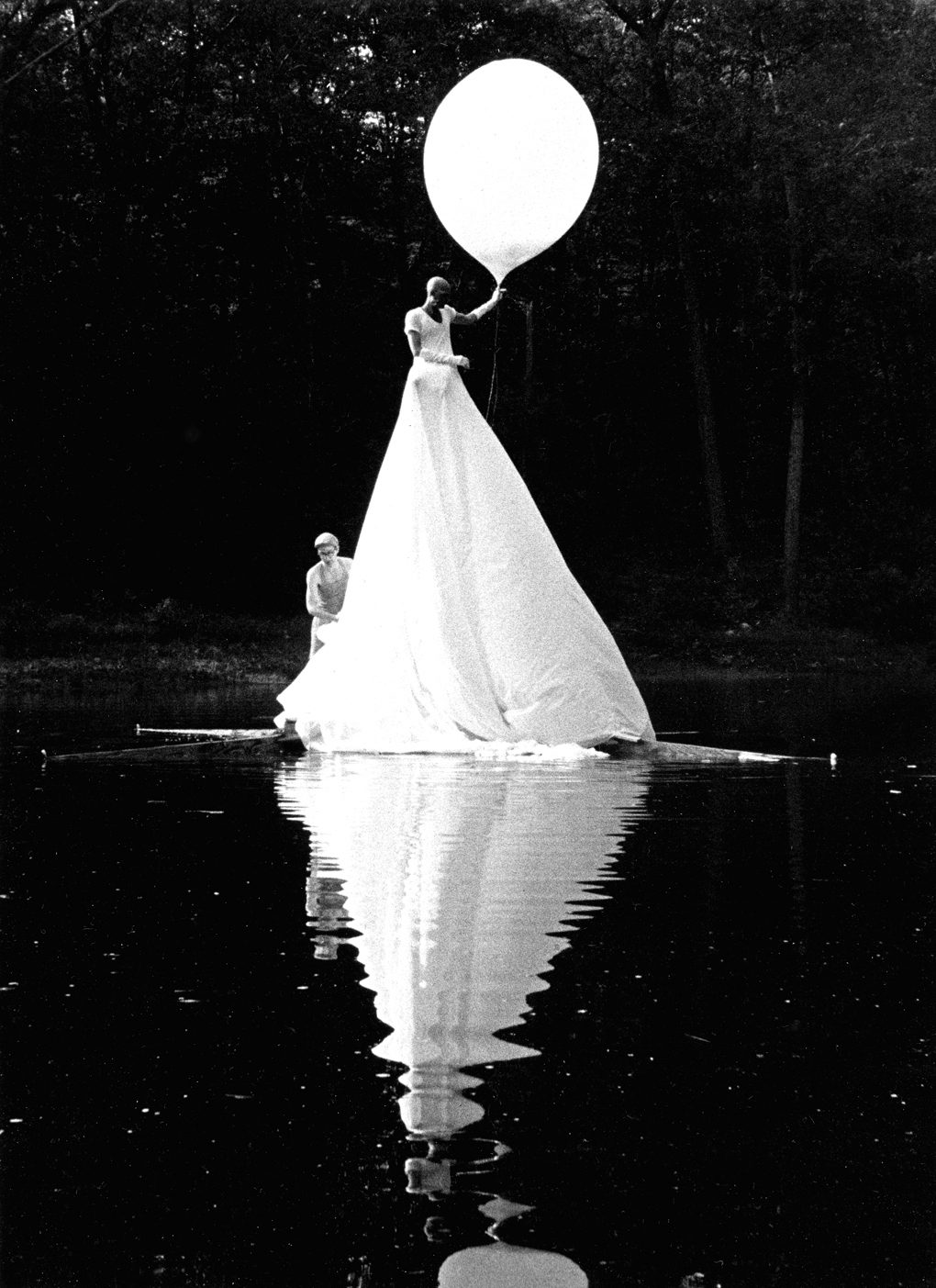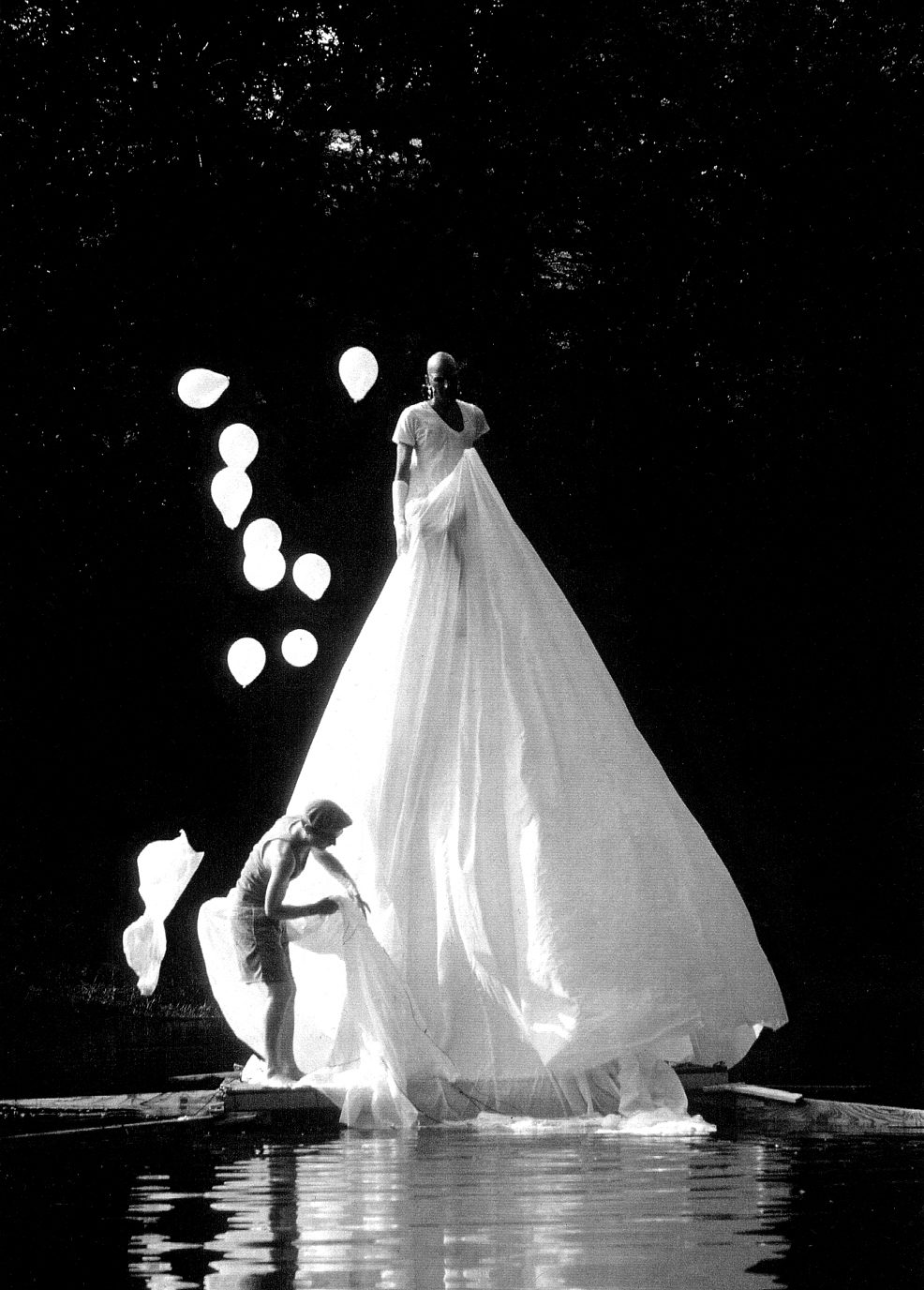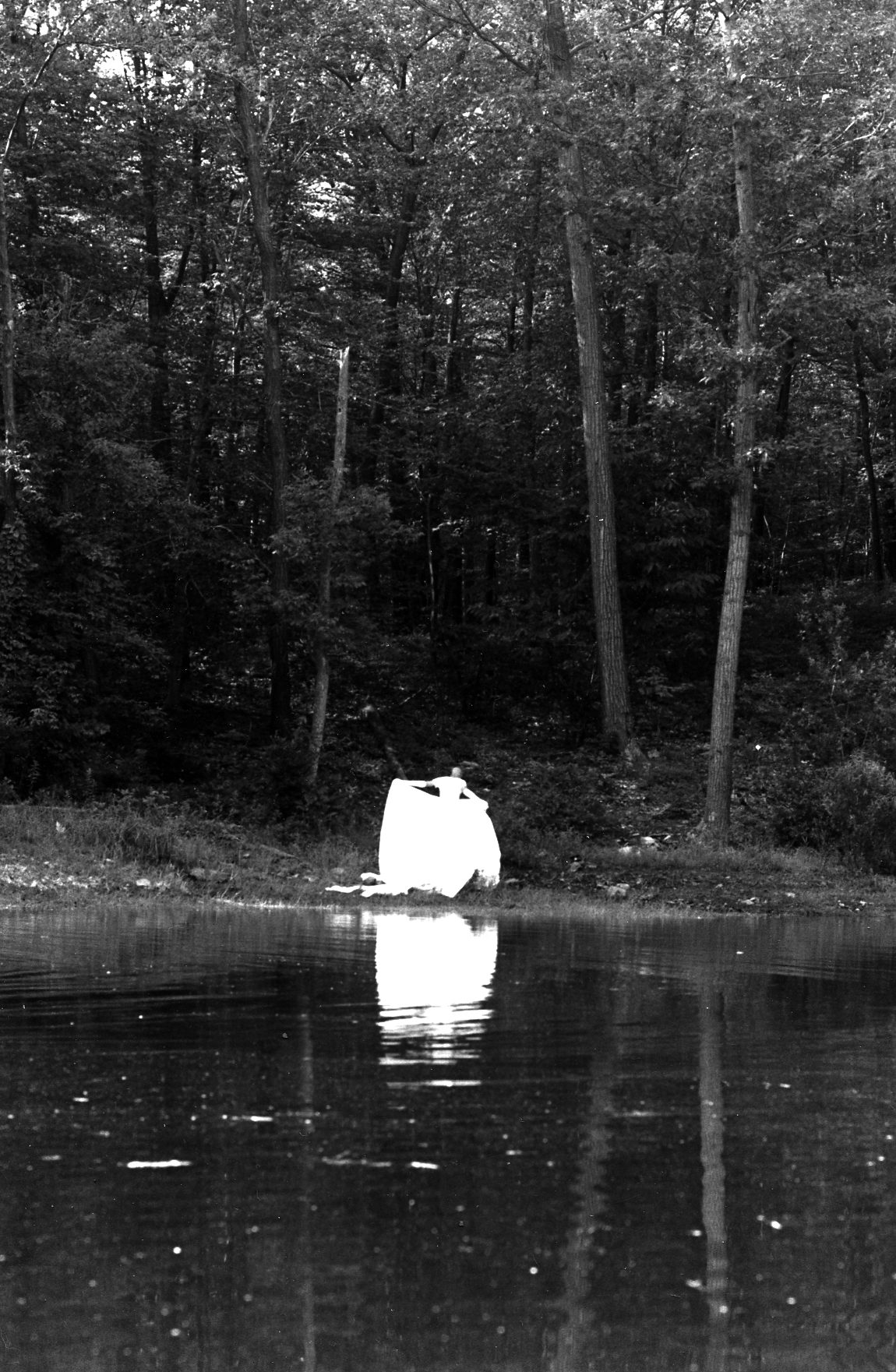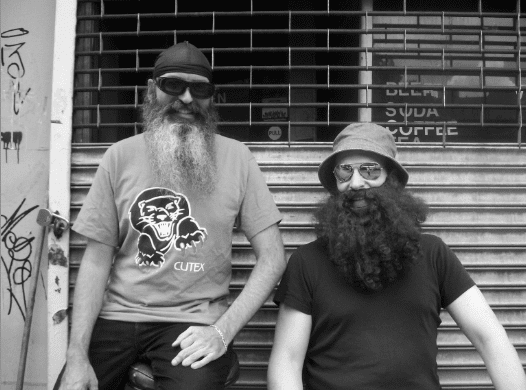Rafael Sánchez, Bedtime-story, 1993. Photo by Claire Barnier.
BESIDE THE BED
Someone has shut the shining eyes, straightened and folded
The wandering hands quietly covering the unquiet breast
So, smoothed and silenced you lie, like a child, not again to be questioned or scolded:
But, for you, not one of us believes that this is rest.
Not so to close the windows down can cloud and deaden
The blue beyond; or screen the wavering flame subdue its breath:
Why, if I lay my cheek to your cheek, your grey lips, like dawn, would quicken and redden,
Breaking into that old odd smile at this fraud of death.
Because all night you have not turned to us or spoken
It is time for you to wake; your dreams were never very deep:
I, for one, have seen the thin bright, twisted threads of them dimmed and suddenly broken.
This is only a most piteous pretense of sleep !
— Charlotte Mew
1869-1928
Balloon(s) Talk
(A conversation in NYC, from November 2004, on BEDTIMESTORY / BOOG-A-LOO performed at the Rushmore Festival in NY, July 4, 1994, by Rafael Sánchez, Mike Grimes, Mark Neston, John Schachter)
Jim Fletcher: You performed Boog-a-loo twice?
Rafael Sánchez: No, once. We performed what we used as the intro to Boog-a-loo on the same site the previous summer, in 1993, as part of an outdoor sculpture project, Outside Possibilities that Bill Arning curated on the grounds of the Rushmore Festival. My invitation was to create a performance work for the opening event. I chose to utilize the lake, out back. The original piece was called Bedtimestory. Bill had asked me to make it memorable. I guessed that it was when the festival invited me back afterwards to elaborate on what I had done for Bill’s show which then became Bedtimestory + Boog-a-loo the following year. So Bedtimestory was performed twice and Boog-a-loo only once, later. Bedtimestory, the first time, was performed with Matthew Benedict and Mark Neston. Mike Grimes worked with me on the soundtrack for both, but he replaced Matthew on the raft the following year.
J: What was the virginal experience like? The 1993. I mean, I like that the raft also works as a stage…
R: Floating like on a bed into sleep. And I had come across the Charlotte Mew poem from the turn of the last century, “Beside the Bed,” which, aside from the setting of the lake, was my point of departure. Mew wrote the poem in wake of the death of her sister.
J: I like looking at the landscape as I listen to the soundtrack you made with Mike Grimes.
R: Well, the first time around it was storming violently all day… and there was this gathering for the occasion… busses of people had come from New York City for the outdoor sculpture show and the stormy weather kept everyone inside. But we were the performance, so we proceeded as if we were going to go through with it, the show on the lake… We set it all up in total chaos. Extreme sound wiring, on the fly, never worked with these folks before… and through all kinds of rain and mud. So at the end of the day it was like, “How did you do that?” Well, you hear this sound from the lake, (we had the Black Sabbath storm with the bell built into the soundtrack), and you don’t know if it’s coming from the weather or not. It was coming out of the forest somewhere where we rigged everything. And here we are, these figures from the distant shore, slowly drifting towards the shore where the people assembled … I remember very clearly. We were scheduled for 2pm. It was pouring rain. The first bus left at 3pm and another was about to leave at 3:30. We launched the piece at 3 just as the weather broke long enough for us to perform for those that stayed for the second bus.
J: Was the raft already there?
R: Yes, it existed as a floating dock which we detached from the shore and rigged. The cordless mike with us on the raft was live.
J: Your performances are like musicals, in a way. Among the songs you used here is the Melanie song, “Candles in the Rain”… it’s very Woodstock.
R: Yes, New York state, and the Hudson River Valley are historical in that way and I guess I extended that feeling by using that song. The choice was intentionally blatant. It was the early nineties and the AIDS crisis had reached a critical tipping point and had become a significant force in most of our lives. The lyric of the song was pertinent and took on new meanings twenty five years after Melanie wrote it about Woodstock. “We bled inside each other’s wounds… We all had caught the same disease”… and its about love and it refrains with themes of rain and fire which brings us back to the lake and the storm… the setting. Its also about being unbound… and together.
J: So you went from Bedtimestory… sleep into a dance, Boog-a-loo.
R: Yes. There were so many themes that were running through my mind as I assembled both pieces. After the first run with the raft I couldn’t help thinking about the boat lifts from Cuba and the theme of personal exodus… and yes to make a dance of it at least in my mind, hence Boog-a-loo. And yes sleep into dance… so its kind of a soupy phrasing. Looking back now it all seems very raw, thematically, anyway. I think that’s why now I like to refer to the singular images as perfect… they somehow strip the moment to its essentials.
J: It looks shrouded in the past.
R: Well, in a way we can’t help going back. And the past is an ever-present resource. But ultimately as much as you go back, you ask yourself what does that mean to me now? Then there is no irony or nostalgia. It’s an engagement with the present that is interesting.
J: Right, like playing a song that was made years ago now seen in a new light. It’s like living backwards… what’s going on now somehow changes the past.
R: At the risk of sounding grandiose, it’s an ancient song, really. Sometimes I feel that I’m working within a template that’s already been prescribed. What’s great is working through it and actually living it and understanding what these things are made of inside of a life. And it has to be your life. That’s the only real reference and that’s where it has its power.
J: And conflict.
R: Yes. And the romanticism gets stripped away.
J: What do you mean?
R: Well you have to fight. The intricacies of life don’t necessarily want to go there with you and accompany the things you’ve come to believe in, or for that matter the things you desire or envision. So these intricacies have to somehow move towards the work. And you can’t do it alone. You have to find your brethren. This is not romantic. This is real.
J: I like what you said once about going at it as if you’re making something, and then you realize that you’ve placed yourself with it into an unpredictable situation. That’s why I like the balloons so much. You never know what they are going to do.
R: You never know. You can structure the work as much as you want, but there is always that thing that will surprise you.
J: And there is nothing more surprising than a balloon. Even if you’re just watching it get bigger and bigger and you know it’s ready to pop… but, God damn when it pops. [… !!!]
R: They are enigmas. Almost sphinx-like. They have this life to them but you don’t know what that life is at all.
J: And these balloons have something benevolent to them. There’s something about their silence. Also the guys on the raft, they also have great spirit to them… they’re not selfish at all. They’re workers.
R: They’ve given themselves to it.
J: Right, and not only have the balloons given themselves… but they are up there in the sky taking it all up.
R: Well the whole thing is a machine really. And a machine has many parts that work together at once. But the balloons are ultimately benign. They’re just doing their thing… going with the flow.
J: Yes. And they give themselves up at the first request…
R: Every thing about it is doing that. For example, the elements at play: air, water, earth, then the balloons explode an we have fire. These are the elements engaged within a gesture. And I wanted this experience that would reveal this somehow. And I wanted these things to maintain a continuity and a relationship to each other. It’s an ancient engine, really. That’s the power of it. But you don’t even notice that this is what’s making it work.
J: Yes, you don’t want to bug out on the fact that the raft is floating on the water.
R: Well, it’s an exaggerated gesture. A grotesque, if you will. You’re floating and then that gesture is extended up. And in a way it’s a symbol of the desire to break free of flesh and / or of gravity, or whatever is holding you. But ultimately we don’t and that’s what’s interesting… how that gesture rubs up against reality. And the caress is unsettling… and the caress is also sweet.
J: Then the dress is pulled all the way up and that’s a great moment… your flesh exposed. There’s something very moving. It’s like a love affair. You don’t just want escape. The part that holds you is total hot love. With your dick out… with the dress up in the air, and the balloons popping. That’s a hot time right there. And it’s a love affair. And at times its like a fight. Especially at that moment when the gunpowder zippers ignite and pop the balloons. And your nakedness under all the white cloth is so… well, it’s got something like the indignity of underwear.
R: Earthy.
J: Its juicy. And this thing about being free of your bounds is just half of it. That’s just half of the love affair. I find that the matter, or what you describe as the circumstances of life, or what holds you… you could just as easily describe that as the unreal and the part that’s ascending could be the real.
R: They flip-flop. They toggle and they’re interwoven. That’s where art exists.
J: And the past and the present do that too. Just like when the thunderstorm stopped and you guys had the thunderstorm sound tracked all-ready. It’s as if you made the break in the weather, but actually you just got your asses in gear and went out and went for it when the weather broke. But everyone was flipped out because it looked like the weather broke for you. That was a flip-flop of circumstances. You guys were down and dirty, slogging in the mud, and you’re asking yourselves, “are we even going to get a chance to do this?” And people were doubting you. But when it was done, the tables were reversed. It’s like then everything broke for you, and it was divine, and everything else was like the earth and the mud. It just toggled on you. It’s like living backwards. And the music did it too. It’s as if that song was made for now, that’s how precedence serves what’s happening, it’s as if this present thing actually preceded or caused the other. And that happens a lot with your work, because you launch yourself. You made a machine right there where you just set yourself into the elements. It’s not like you knew how you were going to control everything, but you wanted to make a machine… like a Jules Verne machine… like the balloon in Mysterious Island. You set yourself into the elements, and then whatever’s going to happen is going to happen, but you addressed it as completely as you could, with the dress and the music…
R: You know that you don’t know what’s going to happen. You create the machine and when the elements take over you see what it really is.
J: It’s like building a ship.
R: And you want to go somewhere with this ship, but you don’t know where you’re going to go… really.
J: And you don’t know what’s going to happen with your canvases and things that are made to catch the elements and to float and to fly and to… go somewhere… and to be beautiful.
R: So it’s like to be unbound is really to be bound, right? Is that the lesson of the balloon?
J: What do you mean to be unbound is to be bound?
R: Well, you actually go through with it and create this gesture that in a way is a desire to break free, and explore and to touch the cosmos, whatever. And then you realize that to feel the mud and to actually go through it in real time and a real physical place with real circumstances and people and what everything is actually made of… is that where we find meaning in the work?
J: I find that it’s so much like lovers. The part that’s bound is like somebody who doesn’t want to let go of you, or when you toggle… –you want to say “you”– like always you have at least a couple of different entities going on so “you” the one that’s down there as opposed to “you” the one that’s up there… but it’s a real love problem.
R: It is.
J: There’s jealousy….
R: Very much so…. That’s the rub. It’s almost like we cannot be noble. Maybe that’s what I mean — it’s like wanting to be free of these things, these bounds, and expect to be noble.
J: You’re trying to leave your lover!
R: But you cannot do that. Yeah, you can’t leave your lover and be noble. It’s a huge conflict. The conflict is the setting for it all. I think so. Real human feeling. We’re very complex. You want your cake and eat it too constantly in life. These are the things we explore in art. With the paintings it’s the same thing, it’s that tension, really… that’s the running theme…. because you love your lover.
J: Totally. Let him try to go away and see what you do, you know? Then it toggles.
R: It constantly turns.
J: It’s funny that toggle, you have to be on the toggle. You have to understand the toggle.
R: That’s the song. That’s the song. That’s constantly the song.
J: It’s like that ship. And a lot of the instruments on this ship are symbolic instruments, they’re symbols but they work as instruments. You know classically when you see a symbol, it strictly is the symbol standing for something. But when the symbol is actually like an instrument on a ship, like an astrolabe or something, or like the dress, it’s a symbol that can toggle into a material item… anything could toggle back into that exalted position that the dress is in. Look at that dress at the end when you’re dragging it through the woods. That’s crazy! After all that, and then it’s just bedraggled like underwear that’s been tossed aside, and been rained on!
R: It always ends up there, in the end.
J: I love that you get there. What if you ended it in the middle, when the dress is up in all it’s glory…?
R: As nasty as that mud can be, it’s full of life?
J: Yeah, it’s scary how full of potency it is. It’s not just placid fertility. It’s frightening. That pool is active.
R: Yeah, we set up a situation and then you know, you start to see all the details. All the details that are in the funk. It’s a machine unto itself. Like on that lake, you know, it was just filled, filled with balancing organisms, and tadpoles, and frogs, and nests. And in the woods there were rattlesnakes…
J: Really?
R: Yeah. And all kinds of creatures. It’s all so very alive, and when you experience those things, you wonder about the minuteness of your own gestures… Like to all that life that was going on around us during that piece, all that life could really give a fuck about what we were up to and struggling to create. Somewhere though I imagine all the tadpoles and rattlesnakes cheering us on… because it’s a life force thing, and in that way we’re actually cheering them on too… right? It’s just a moment in time really. If the photographer hadn’t been there it would have been really like kind of nothing, you know? So the ethereality of it is powerful too.
J: Well you said that looking at the stills is almost the preferred way to see it.
R: The beauty of it for me now is that it exists that way as moments, and certainly for whomever happened to be there, with all its roughness. And running into people that did see it, on occasion, you realize that what does stand out is that image, the kind of singular image of the moment…. Sometimes I feel like I know I’m going to kind of walk into a dream, then I go into it, you know, in the way you go to sleep. There’s going to be a newness to it because these are not common places or events as much as they may pretend to be and time becomes irrelevant. And I listen to that, the voice of the dream, the one that doesn’t have any rules, and it’s always surprising you.
J: I guess in some ancient models the masculine is the sky and the earth is the feminine, the fertile. But in this, it’s not exactly like that, if anything the masculine lover is the one that comes from underneath.
R: It’s all rolled into one, this is where the androgynous aspect is for sure. In this piece the masculine and feminine are together in fertility. And I don’t mean fertility in the sense of generating human life. I mean within the cosmic realm: a fertile engagement with the whole universe, it is fertility and passion as a whole thing, and of ideas, and of engagement with the world on its own terms. When you do that you’re engaging with beauty, no matter where you turn. And this is the androgynous quality we’re striving for.
J: The fertility of a balloon which is a membrane that’s holding a different kind of air on the inside from what’s outside, that’s a kind of fertile conflict. Because of the tension of that membrane.
R: And the membrane describes androgyny as in that it equally holds and reveals. When I first performed with a balloon on stage, per chance just doing a very small act, it blew my mind. Holding the balloon suspended in time and space in front of everybody… the power of it was so fantastic I wondered a lot about it. I wondered where that was coming from. It was a symbolic energy… of the way the balloon exists… it had a very singular, androgynous power.
J: I love symbolism that is like an instrument. It’s not the end, it’s not a terminal symbolism. But one thing I love also about balloons is that they give themselves up on the first encounter with some kind of objecting force… pop! okay, gone.
R: Remember when we were first trying to figure out how to get inside a balloon? You were the first person to help me try that: I said to myself, “I know I want to be in this balloon, how are we going to do this?” And we just kept fumbling through it. The balloons kept teaching us things with each try. It was the balloons telling us. They were speaking to us…. And I knew it would take time, because we needed to learn. And it was like, “We aren’t going to teach this balloon tricks, it is going to teach us a few things.” So we engineered around the balloon.
J: Right, and we only had but so many balloons we could use so we had to learn as much as we could each time. That was great. And still, it was all like, “I wonder if this is going to happen?” And it never worked! Until we did it in the performance. We had never had a successful dry run. Never. It only seemed to work with the audience.
R: Is that the lesson of the balloon? What’s that about? I’m always amazed by that. Everything is telling you No, no no, no no. Then suddenly, when the moment comes, when you have everything to lose and the audience has gathered, and somehow it gives itself up to you. Because ultimately you become equal with that force, in your will. Somewhere I feel that your will is being respected. Like the moment has come and everyone is in on it with you and there it is, shared… living and present.
J: It really reminds me of Jules Verne, he launches himself into the circumstances, the weather, the balloon falling, and not knowing exactly where he is geographically, but once you’ve made your vessel, to launch yourself, you’ve entered yourself into the circumstances, and you’ve built this thing like a ship, and whatever happens is what happens, that’s the lesson of the balloon.
R: There’s no model, and no script. And all you can do is build a machine, you know, the armature for it. And in a way it’s kind of like, you’re just playing because you don’t know, it’s all kind of like…
J: Like the Wright Brothers.
R: It’s all mockery because you realize that you don’t know anything, you just have this kind of… desire… but it’s really… pretension.
J: It’s like all those old films you see of airplanes when they were trying to make airplanes, trying to fly, they are amazing.
R: Yeah and the failures are so much more interesting than the Wright Brothers actually flying. It’s almost like it’s all over now. Once they finally figured out how to fly the fun was all over.
J: Right. You just can’t fly that way anymore. When you become unbound you’re actually bound. Because once they realized flight, now, you have to go to the airport and get on it, you know… it’s like taking a bus.
R: It’s not a feeling of freedom at all. The freedom was in the desire to fly… that was the love affair, and that was the freedom, and once you got what you wanted…
J: … one of the lovers got dropped. And it’s not there anymore.
R: No.
J: It’s gone.
R: It’s gone… flying is banal now… even tedious.
J: Right because one of the lovers got dropped!
R: You’re not in it anymore
J: Right, it’s not happening, it’s not happening! But to be bound, which can mean to be held, also can mean to be bound for something or somewhere: To be bound…!
R: Yes!
RAFAEL SÁNCHEZ is a Cuban born artist practicing in New York City. He worked for Robert Whitman Projects (Dia Art Foundation) while studying at Rutgers University (1981-84), He was a founding member of Aljira, a Center for Contemporary Art, located then in Newark’s Roseville neighborhood. Look Don’t Touch (presented there in 1985), utilized a nearby highway underpass as an inter-zone of existential intimacy. He has since created works for rooftops, canals, barges, urban, suburban and rural contexts. It was at a work set in a garden in Brooklyn, performing as a flower, that Rafael and Jim Fletcher became friends. Other project venues have included Usine Ephemere (Paris, 1989), Foundation ELBA (Netherlands, 1993), X-Teresa Arte Actual (Mexico City, 1996), Braziers (UK, 1999 and 2004). In New York City projects have been presented at Participant Inc, as well as numerous presentations for Visual AIDS. In partnership with Kathleen White, works were realized for Art in General, El Museo del Barrio, MoMA Library. A Rake’s Progress, an installation by the collaborators was presented at Momenta Art, NY in August (2014). One of Rafael’s paintings becomes a wallpaper and curtain in AIDS at Home; Art and Everyday Activism, currently on view at The Museum of the City of New York (through October 22).
About the Interviewer:
JIM FLETCHER‘s first professional theatrical performance was in Mr. Sánchez’s The Libation Bearers (Thread Waxing Space, 1999), sparking an enduring collaborative friendship. A loose retelling of Aeschelus’ tale, The Libation Bearers was re-scripted around a soundtrack of early catalogue (no synthesizers) Queen songs. Mr. Fletcher is a longtime member of the New York City Players, Elevator Repair Service, The Wooster Group, and the English theater company Forced Entertainment (Sight is the Sense That Dying People Tend to Lose First and Quizoola!), most recently in Cairo, Egypt. In 2011: Sarah Michelson’s dance piece Devotion (The Kitchen, NYC, with text by Richard Maxwell). Film: Utopians (Zbigniew Bzymek, 2011); Bass Ackwards (Linas Phillips, 2010); Raptorious (Kamal Ahmed, 2007). He is also a participant in the writing projects of Bernadette Corporation. He won a 2012 Obie Award for Sustained Excellence.
Read more by Rafael Sánchez:
Rafael Sánchez and Kathleen White’s environmental magazine: alLuPiNiT
More work at Visual Aids
